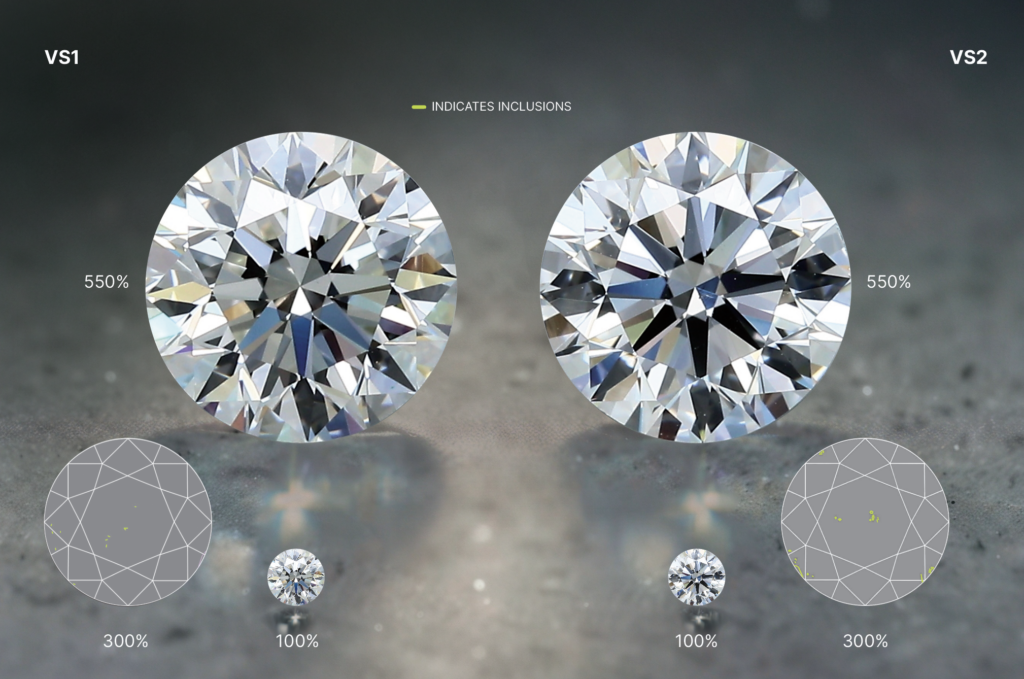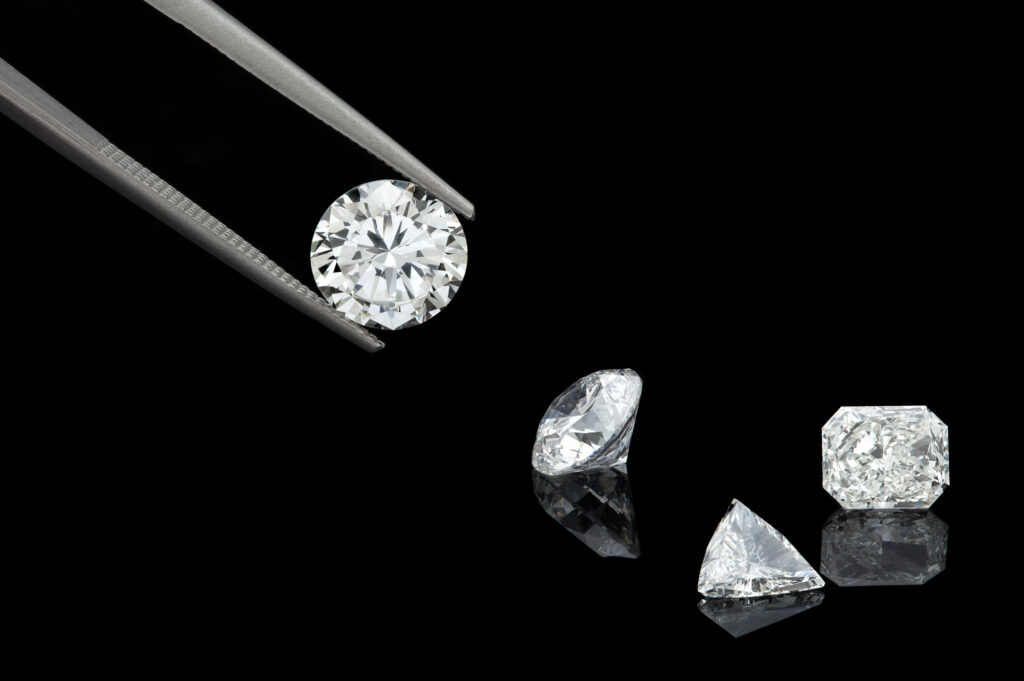Carat, cut, clarity, and color help diamond buyers better understand the quality of the diamond they’re buying and the reason for its costs.
VS1 vs VS2 is one ranking in clarity that tells you about a type of inclusion in a diamond.
Are you considering a diamond purchase in the future? Read on to learn more about the 4 Cs of diamond buying, including the clarity ranking of VS 1 and VS 2.
When you purchase a diamond, there are many things to consider. Most people look to a diamond to sparkle and to be large enough to get noticed.
One classification for diamonds is clarity. A VS diamond is ranked as ‘very slightly included.’ This means the diamond has slight imperfections.
These are so slight they aren’t visible to the naked eye. In fact, imperfections can even be difficult to spot when magnified ten times over.
As you look at different types of diamonds, shapes, cuts, and sizes, you may hear the term VS. It’s one of the eight diamond clarity rankings. These include:
The VS describing a diamond means there are very slight inclusions that are a part of the diamond. Again, it’s worth noting that often an inclusion isn’t visible to the naked eye.
Carat, cut, clarity, and color help diamond buyers better understand the quality of the diamond they’re buying and the reason for its costs.
When a diamond gets a grade, like VS 1 or VS 2, there must be a distinction for why it receives one grade over the one above or below.
So, what are the key differences to why a diamond might be graded VS1 over VS 2?
A VS diamond, remember, will have slight inclusions not visible to the naked eye. A VS 1 diamond is likely to have inclusions that might include:
A VS 2 diamond will likely have inclusions that include:
So, how do each of these descriptions show up in a diamond? How is one different from another? Let’s take a closer look at some of these types of inclusion in VS1 and VS 2 diamonds.

Are you in the process of choosing a diamond, but aren’t sure which direction to go? Come talk to us for a no-strings chat in our store. We’ll give you all the info you need and guide you in the process, so you can make an educated decision. Just book your meeting here by choosing the best date and time for you, and we’ll see you then.
Often a diamond with a cloud inclusion will have a group or collection of inclusions. As the name suggests, cloud inclusion can impact how brilliant a diamond will sparkle.
Some cloud inclusions make a diamond appear hazy. A diamond with many of these types of inclusion can be referred to as a cloudy diamond.
A feather inclusion is one likely in a VS 2-grade diamond. Unlike how it sounds, a feather is actually an internal crack in the diamond. Remember, this isn’t likely visible to the naked eye.
How transparent the feather or crack appears will depend on its position on the diamond. Understanding such characteristics is essential for an affordable diamond auction guide, helping buyers assess the quality and value of diamonds accurately.
When you understand how diamonds are made naturally, you can see how a crystal inclusion could occur. A crystal inclusion is actually a piece of mineral within the diamond itself.
Some of the crystals will be colorless. Other times the mineral will have a color with it, often black, greenish, or reddish.
It’s worth noting that most crystal inclusions get a VS 1 grade.
The exception to that crystal grade is for a knot inclusion. A knot is a type of crystal inclusion. Instead of the mineral being inside the diamond, it’s on the surface of the diamond.
For this reason, a knot inclusion (a crystal one because it’s a mineral) gets graded lower as a VS 2.
Sometimes, a knot inclusion can be visible to the naked eye. Understanding these distinctions is important when evaluating certified diamonds in Tempe, ensuring transparency and accuracy in diamond quality assessments.
When a diamond is mined, before it becomes a valuable piece of jewelry, it must first be polished.
When a part of the diamond is left unattended during the polishing process, it gets graded typically as a VS 1.
This type of inclusion is usually found at the girdle of the diamond.
As the name suggests, a needle inclusion is a long and thin type of inclusion. It’s also a crystal inclusion that presents as white or translucent.
As you consider buying a diamond, you might wonder whether you should purchase a diamond with a VS ranking.
Are they a good investment? Should you seek a diamond with a higher clarity ranking?
Experts believe that a diamond with a VS rating is a smart investment in many cases. While the diamond may not be flawless, it doesn’t have large inclusions that would be visible to the naked eye.
From an investment perspective, a VS diamond will hold value or appreciate over time.

Diamonds with a grade of VS or Very Slightly Included can either be ranked as VS 1 or VS 2. These inclusions will impact both the quality and costs of the diamonds with this ranking. When shopping for diamond rings in Phoenix, understanding these grading distinctions helps in making informed decisions about diamond purchases.
Let’s take a closer look.
When considering quality, there is a difference between a VS 1 and a VS 2.
A VS 1 diamond won’t have inclusions visible to the naked eye or up to ten times magnified.
A VS 2 diamond will only have inclusions visible with the naked eye 5% or less of the time. More inclusions than that would change the grade to a lower ranking.
Any diamond price has many factors. If you buy a diamond with a VS 1 or VS 2 ranking, you’re getting a lovely stone. The price difference between these rankings will likely be minimal if all other factors are equal.
Many experts suggest that investing in a diamond with a VS rating can be a wise choice in many situations. While the diamond might not be completely flawless, it lacks imperfections that would be visible to the naked eye. From an investment perspective, a VS diamond tends to maintain or increase its value over time. However, there are factors to take into account when deciding on an investment. For those considering elegant diamond rings in Scottsdale, understanding diamond grades and their impact on value is crucial..
Ultimately choosing between a VS1 and VS2 diamond depends on factors like size, cut and budget. If you’re looking for something investing in a VS1 would be your bet. Most diamonds over 1 carat, those with step cut shapes are more likely to have clarity at VS1 and appear cleaner to the eye. This means they have flaws making them more attractive to potential buyers and potentially increasing their resale value.
Considering the size of the diamond is also crucial. Larger diamonds generally have investment potential as they are rarer and more sought. Additionally the way the diamond is cut greatly affects its appearance and value. A cut diamond will display sparkle and brilliance making it more desirable for buyers and potentially increasing its investment worth.
Lastly your budget plays a role, in your decision making process.
When it comes to considering a diamond it’s important to keep in mind that while it may have investment potential it could also come with a higher price tag. It’s crucial to evaluate the investment potential, in relation to your limitations so you can make an informed decision.
To summarize opting for a VS diamond can be a move since it strikes a balance between quality and value. However when thinking about investing it’s essential to consider factors such, as the clarity grade, size, cut and your budget in order to maximize the returns.
A diamond with a VS 1 or VS 2 is likely a beautiful diamond worthy of consideration. When you consider VS1 vs VS2, the differences are minimal and often not visible to the naked eye.
VS1 and VS2 diamonds are clarity grades in the Very Slightly Included category. These diamonds have minor inclusions that are difficult to see under 10x magnification, making them popular choices for engagement rings.
VS1 diamonds have slightly fewer and smaller inclusions than VS2 diamonds. However, both grades offer excellent clarity, with inclusions typically not visible to the naked eye.
VS1 diamonds are generally more expensive than VS2 diamonds due to their higher clarity grade. However, the price difference will vary depending on other factors such as cut, color, and carat weight.
Both VS1 and VS2 diamonds are excellent choices for engagement rings. They offer a balance of quality and value, providing eye-clean appearance without the premium cost of higher clarity grades.
When choosing between VS1 and VS2 diamonds, consider your budget and priorities. If the inclusions in a VS2 diamond are not visible to the naked eye, it offers better value. However, if you prefer the assurance of fewer inclusions, go with a VS1 diamond.
Deciding between the two diamonds, and not sure which is best for you? Drop in for a no-strings visit and we will guide you through the diamond education process so you can make the decision with confidence.
Just book your appointment using the calendar below, and we’ll see you then.
Do you have a vision for your custom engagement ring, but aren’t sure how to make it a reality? Allow us to guide you through the process of how to create truly exceptional rings. Schedule your design appointment today and see how Finer Custom Engagement Rings and Diamonds will bring your vision of an engagement ring to life.
© Copyright Finer Custom Jewelry 2024